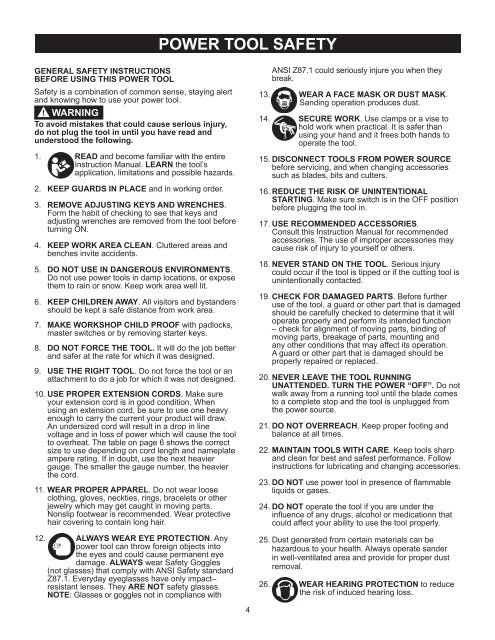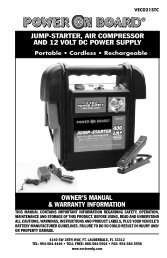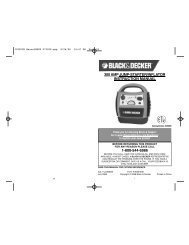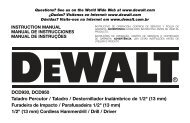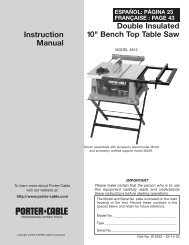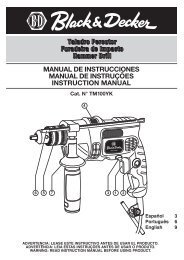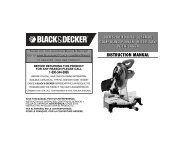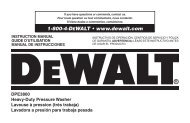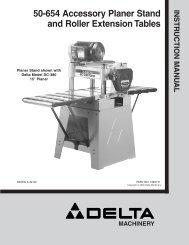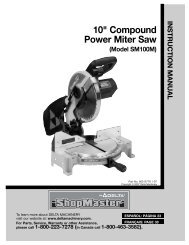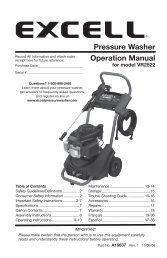4 IN. x 8 IN. (102 MM x 203 MM) BELT / DISC SANDER PONCEUSE ...
4 IN. x 8 IN. (102 MM x 203 MM) BELT / DISC SANDER PONCEUSE ...
4 IN. x 8 IN. (102 MM x 203 MM) BELT / DISC SANDER PONCEUSE ...
You also want an ePaper? Increase the reach of your titles
YUMPU automatically turns print PDFs into web optimized ePapers that Google loves.
GENERAL SAFETY <strong>IN</strong>STRUCTIONS<br />
BEFORE US<strong>IN</strong>G THIS POWER TOOL<br />
Safety is a combination of common sense, staying alert<br />
and knowing how to use your power tool.<br />
! WARN<strong>IN</strong>G<br />
To avoid mistakes that could cause serious injury,<br />
do not plug the tool in until you have read and<br />
understood the following.<br />
1. READ and become familiar with the entire<br />
Instruction Manual. LEARN the tool’s<br />
application, limitations and possible hazards.<br />
2. KEEP GUARDS <strong>IN</strong> PLACE and in working order.<br />
3. REMOVE ADJUST<strong>IN</strong>G KEYS AND WRENCHES.<br />
Form the habit of checking to see that keys and<br />
adjusting wrenches are removed from the tool before<br />
turning ON.<br />
4. KEEP WORK AREA CLEAN. Cluttered areas and<br />
benches invite accidents.<br />
5. DO NOT USE <strong>IN</strong> DANGEROUS ENVIRONMENTS.<br />
Do not use power tools in damp locations, or expose<br />
them to rain or snow. Keep work area well lit.<br />
6. KEEP CHILDREN AWAY. All visitors and bystanders<br />
should be kept a safe distance from work area.<br />
7. MAKE WORKSHOP CHILD PROOF with padlocks,<br />
master switches or by removing starter keys.<br />
8. DO NOT FORCE THE TOOL. It will do the job better<br />
and safer at the rate for which it was designed.<br />
9. USE THE RIGHT TOOL. Do not force the tool or an<br />
attachment to do a job for which it was not designed.<br />
10. USE PROPER EXTENSION CORDS. Make sure<br />
your extension cord is in good condition. When<br />
using an extension cord, be sure to use one heavy<br />
enough to carry the current your product will draw.<br />
An undersized cord will result in a drop in line<br />
voltage and in loss of power which will cause the tool<br />
to overheat. The table on page 6 shows the correct<br />
size to use depending on cord length and nameplate<br />
ampere rating. If in doubt, use the next heavier<br />
gauge. The smaller the gauge number, the heavier<br />
the cord.<br />
11. WEAR PROPER APPAREL. Do not wear loose<br />
clothing, gloves, neckties, rings, bracelets or other<br />
jewelry which may get caught in moving parts.<br />
Nonslip footwear is recommended. Wear protective<br />
hair covering to contain long hair.<br />
12. ALWAYS WEAR EYE PROTECTION. Any<br />
power tool can throw foreign objects into<br />
the eyes and could cause permanent eye<br />
damage. ALWAYS wear Safety Goggles<br />
(not glasses) that comply with ANSI Safety standard<br />
Z87.1. Everyday eyeglasses have only impact–<br />
resistant lenses. They ARE NOT safety glasses.<br />
NOTE: Glasses or goggles not in compliance with<br />
POWER TOOL SAFETY<br />
4<br />
ANSI Z87.1 could seriously injure you when they<br />
break.<br />
13. WEAR A FACE MASK OR DUST MASK.<br />
Sanding operation produces dust.<br />
14. SECURE WORK. Use clamps or a vise to<br />
hold work when practical. It is safer than<br />
using your hand and it frees both hands to<br />
operate the tool.<br />
15. <strong>DISC</strong>ONNECT TOOLS FROM POWER SOURCE<br />
before servicing, and when changing accessories<br />
such as blades, bits and cutters.<br />
16. REDUCE THE RISK OF UN<strong>IN</strong>TENTIONAL<br />
START<strong>IN</strong>G. Make sure switch is in the OFF position<br />
before plugging the tool in.<br />
17. USE RECO<strong>MM</strong>ENDED ACCESSORIES.<br />
Consult this Instruction Manual for recommended<br />
accessories. The use of improper accessories may<br />
cause risk of injury to yourself or others.<br />
18. NEVER STAND ON THE TOOL. Serious injury<br />
could occur if the tool is tipped or if the cutting tool is<br />
unintentionally contacted.<br />
19. CHECK FOR DAMAGED PARTS. Before further<br />
use of the tool, a guard or other part that is damaged<br />
should be carefully checked to determine that it will<br />
operate properly and perform its intended function<br />
– check for alignment of moving parts, binding of<br />
moving parts, breakage of parts, mounting and<br />
any other conditions that may affect its operation.<br />
A guard or other part that is damaged should be<br />
properly repaired or replaced.<br />
20. NEVER LEAVE THE TOOL RUNN<strong>IN</strong>G<br />
UNATTENDED. TURN THE POWER “OFF”. Do not<br />
walk away from a running tool until the blade comes<br />
to a complete stop and the tool is unplugged from<br />
the power source.<br />
21. DO NOT OVERREACH. Keep proper footing and<br />
balance at all times.<br />
22. MA<strong>IN</strong>TA<strong>IN</strong> TOOLS WITH CARE. Keep tools sharp<br />
and clean for best and safest performance. Follow<br />
instructions for lubricating and changing accessories.<br />
23. DO NOT use power tool in presence of flammable<br />
liquids or gases.<br />
24. DO NOT operate the tool if you are under the<br />
influence of any drugs, alcohol or medicationn that<br />
could affect your ability to use the tool properly.<br />
25. Dust generated from certain materials can be<br />
hazardous to your health. Always operate sander<br />
in well-ventilated area and provide for proper dust<br />
removal.<br />
26. WEAR HEAR<strong>IN</strong>G PROTECTION to reduce<br />
the risk of induced hearing loss.


